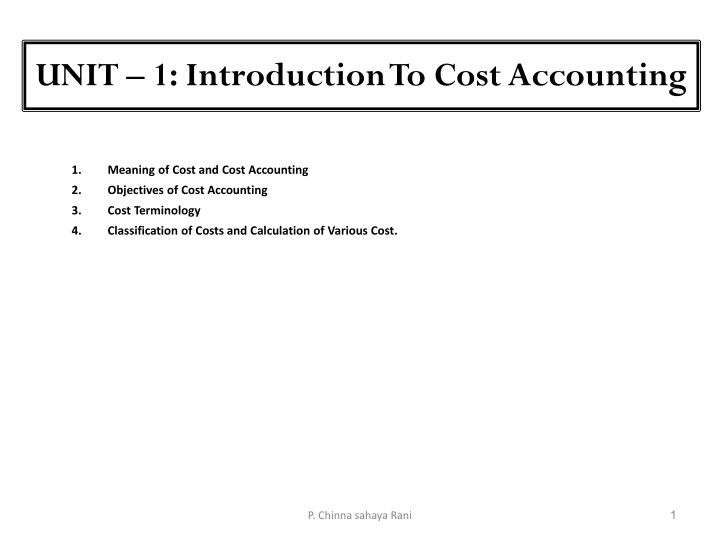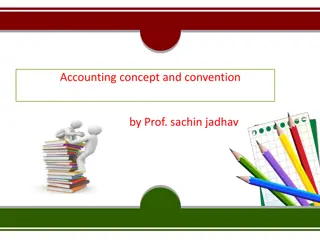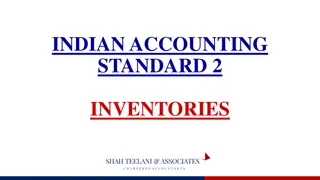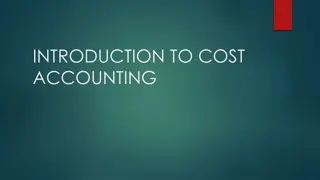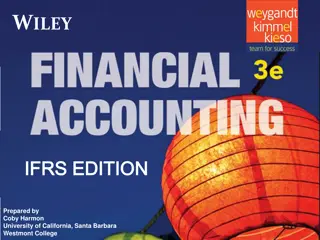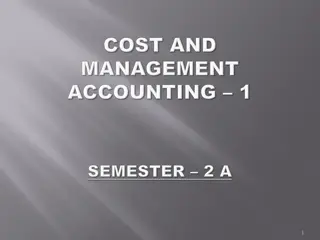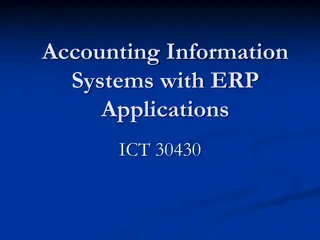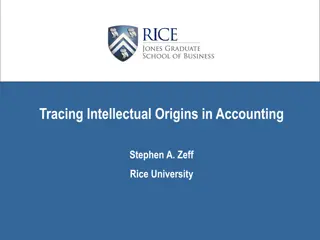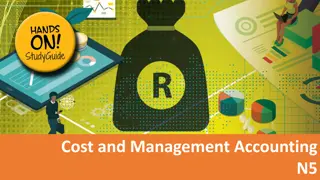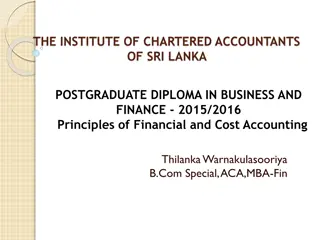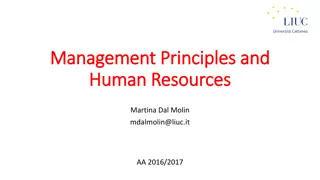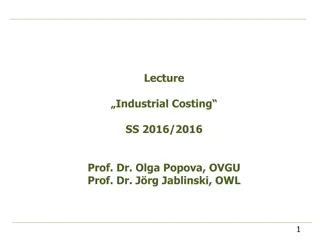Introduction to Cost Accounting: Meaning, Objectives, and Terminology
Delve into the fundamental concepts of cost accounting, including the meaning of cost, objectives of cost accounting, cost terminology, and elements of cost such as materials and labor. Explore how cost accounting helps in determining product costs, cost control, and decision-making for efficient management.
Download Presentation

Please find below an Image/Link to download the presentation.
The content on the website is provided AS IS for your information and personal use only. It may not be sold, licensed, or shared on other websites without obtaining consent from the author.If you encounter any issues during the download, it is possible that the publisher has removed the file from their server.
You are allowed to download the files provided on this website for personal or commercial use, subject to the condition that they are used lawfully. All files are the property of their respective owners.
The content on the website is provided AS IS for your information and personal use only. It may not be sold, licensed, or shared on other websites without obtaining consent from the author.
E N D
Presentation Transcript
UNIT 1: Introduction To Cost Accounting 1. Meaning of Cost and Cost Accounting 2. Objectives of Cost Accounting 3. Cost Terminology 4. Classification of Costs and Calculation of Various Cost. 1 P. Chinna sahaya Rani
1. MEANINGS COST - MEANING Cost means the amount of expenditure ( actual or notional) incurred on, or attributable to, a given thing. P. Chinna sahaya Rani 2
COST ACCOUNTING - MEANING Cost accounting is concerned with recording, classifying and summarizing costs for determination of costs of products or services, controlling and reducing such costs and furnishing of information to management for decision making planning, P. Chinna sahaya Rani 3
2. OBJECTIVES OF COST ACCOUNTING Ascertainment of costs Estimation of costs Cost control Cost reduction Determining selling price Facilitating preparation of financial and other statement Providing basis for operating policy P. Chinna sahaya Rani 4
3. COST TERMINOLOGY COST: Cost means the amount of expenditure incurred on a particular thing. COSTING: Costing means the process of ascertainment of costs. COST ACCOUNTING: The application of cost control methods and the ascertainment of the profitability of activities carried out or planned . COST CONTROL: Cost control means the control of costs by management. Following are the aspects or stages of cost control. JOB COSTING: It helps in finding out the cost of production of every order and thus helps in ascertaining profit or loss made out on its execution. The management can judge the profitability of each job and decide its future courses of action. BATCH COSTING: Batch costing production is done in batches and each batch consists of a number of units, the determination of optimum quantity to constitute an economical batch is all the more important. P. Chinna sahaya Rani 5
ELEMENTS OF COST Element of cost Materials Labour Expenses Direct Indirect Direct Indirect Direct Indirect 6 P. Chinna sahaya Rani
MATERIAL: The substance from which the finished product is made is known as material. (a) DIRECT MATERIAL: is one which can be directly or easily identified in the product Eg: Timber in furniture, Cloth in dress, etc. (b) INDIRECT MATERIAL: one which cannot be easily identified in the product. P. Chinna sahaya Rani 7
EXAMPLES OF INDIRECT MATERIAL At factory level lubricants, oil, consumables, etc. At office level Printing & stationery, Brooms, Dusters, etc. At selling & dist. level Packing materials, printing & stationery, etc. P. Chinna sahaya Rani 8
LABOUR: The human effort required to convert the materials into finished product is called labour. (a) DIRECT LABOUR: is one which can be conveniently identified or attributed wholly to a particular job, product or Eg:wages paid to carpenter, fees paid to tailor,etc. process. (b) INDIRECT LABOUR: is one which cannot be conveniently identified or attributed wholly to a particular job, product or process. P. Chinna sahaya Rani 9
EXAMPLES OF INDIRECT LABOUR At factory level foremen s salary, works manager s salary, gate keeper s salary,etc At office level Accountant s salary, GM s salary, Manager s salary, etc. At selling and dist.level salesmen salaries, Logistics manager salary, etc. P. Chinna sahaya Rani 10
OTHER EXPENSES: are those expenses other than materials and labour. DIRECT EXPENSES: are those expenses which can be directly allocated to particular job, process or product. Eg : Excise duty, royalty, special hire charges,etc. INDIRECT EXPENSES: are those expenses which cannot be directly allocated to particular job, process or product. P. Chinna sahaya Rani 11
Examples of other expenses At factory level : factory rent, factory insurance, lighting, etc. At office level : office rent, office insurance, office lighting, etc. At sales & dist.level : advertising, show room expenses like rent, insurance, etc. P. Chinna sahaya Rani 12
BASIC COST SHEET DIRECT MATERIAL .. DIRECT LABOUR DIRECT EXPENSES PRIME COST . FACTORY OVERHEADS .. FACTORY COST OFFICE OVERHEADS COST OF PRODUCTION SELL & DIST OVERHEADS COST OF SALES PROFIT . SALES P. Chinna sahaya Rani 13
COST SHEET - ADVANCED OPENING STOCK OF RAW MATERIALS +PURCHASES +CARRIAGE INWARDS -CLOSING STOCK OF RAW MATERIALS VALUE OF MATERIALS CONSUMED +DIRECT WAGES +DIRECT EXPENSES PRIME COST +FACTORY OVERHEADS +OPENING STOCK OF WIP -CLOSING STOCK OF WIP FACTORY COST (CONT.) P. Chinna sahaya Rani 14
FACTORY COST +ADMINISTRATIVE OVERHEADS COST OF PRODUCTION +OPENING STOCK OF FINISHED GOODS -CLOSING STOCK OF FINISHED GOODS COST OF GOODS SOLD +SELL. & DIST. OVERHEADS COST OF SALES +PROFIT SALES P. Chinna sahaya Rani 15
4. COST CLASSIFICATION Classification On basis of : Nature Function Direct & indirect Variability Controllability Normality Financial accounting classification Time Planning and control Managerial decision making P. Chinna sahaya Rani 16
ON THE BASIS OF NATURE Materials Labor Expenses P. Chinna sahaya Rani 17
ON THE BASIS OF FUNCTION Manufacturing costs Commercial costs ADM and S&D Costs ON THE BASIS OF DIRECT AND INDIRECT Direct costs Indirect costs P. Chinna sahaya Rani 18
ON THE BASIS OF VARIABILITY Fixed costs Variable costs Semi variable costs P. Chinna sahaya Rani 19
ON THE BASIS OF CONTROLLABILITY Controllable costs Uncontrollable costs ON THE BASIS OF NORMALITY Normal costs Abnormal costs P. Chinna sahaya Rani 20
ON THE BASIS OF FINANCIAL ACCOUNTS: Capital costs Revenue costs Deferred revenue costs P. Chinna sahaya Rani 21
ON THE BASIS OF TIME: Historical costs Pre determined costs ON THE BASIS OF PLANNING AND CONTROL: Budgeted costs Standard costs P. Chinna sahaya Rani 22
ON THE BASIS OF MANAGERIAL DECISION MAKING Marginal costs Out of pocket costs Sunk costs Imputed costs Opportunity costs Replacement costs Avoidable costs Unavoidable costs Relevant and irrelevant costs Differential costs P. Chinna sahaya Rani 23
TERMS IN COST ACCOUNTING Cost unit Cost centre Cost estimation Cost ascertainment Cost allocation Cost apportionment Cost reduction Cost control P. Chinna sahaya Rani 24
METHODS OF COSTING Job costing Contract costing Batch costing Process costing Unit costing Operating costing Operation costing Multiple costing P. Chinna sahaya Rani 25
TYPES OF COSTING Uniform costing Marginal costing Standard costing Historical costing Direct costing Absorption costing P. Chinna sahaya Rani 26
